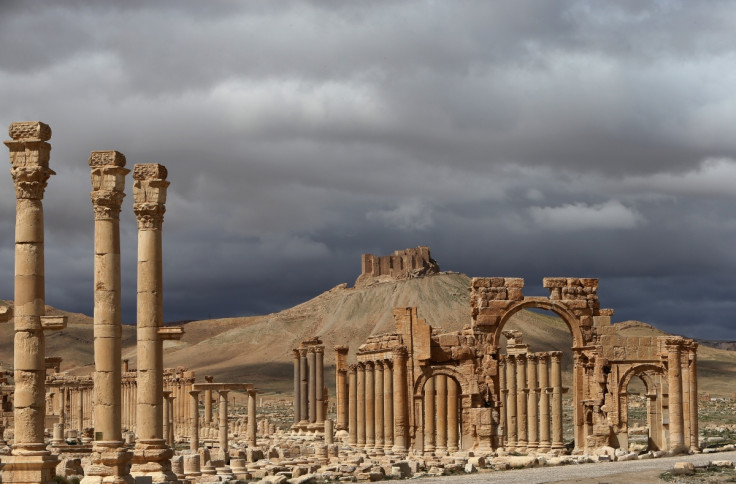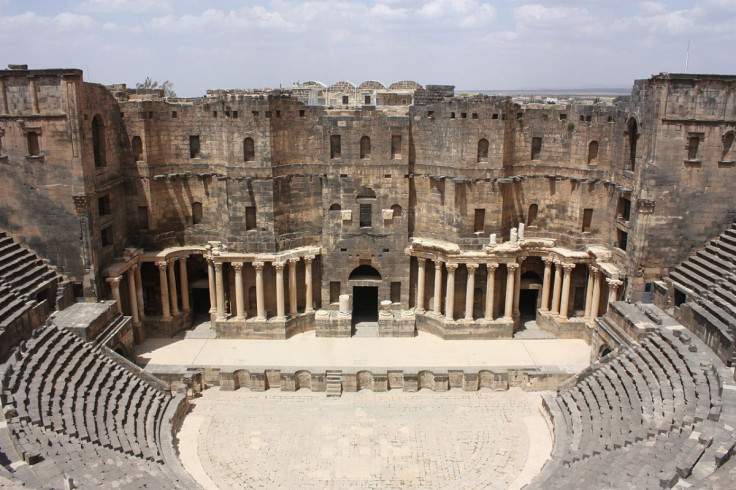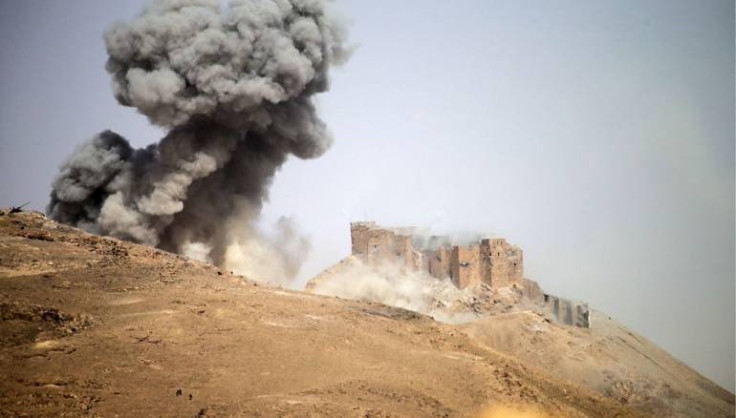Don't pretend Assad will save Palmyra when he has destroyed the rest of Syria

This week the Mayor of London declared that he couldn't "conceal his elation as the news comes in from Palmyra" as "it is reported that the Syrian army is genuinely back in control of the entire Unesco site".
Boris Johnson then ostentatiously shouted his joy in the House of Commons at the so-called "liberation" of the ancient city (essentially the work of Russian special forces and fighter planes, and of Hezbollah militiamen who've been backing the Syrian president all along since the early days of the revolution in 2011).
He has gone even further, by putting forward the idea of sending British architects and archaeologists to the ancient site to restore its obliterated or badly damaged monuments. Such a suggestion to make Syria "glorious" again (with little helmsman Bashar al-Assad still in power, so it seems...) is preposterous, not only because the Syrian regime has propped up jihadists by freeing them from Saidnaya prison in 2011.
The suggestion is ludicrous not only because Assad, through his agent George Aswani, has been one of Islamic State (Isis/Daesh)'s main customers when it comes to buying bootlegged oil, but also as the dictator is the main guilty party in the killing of 350,000 of his citizens in the five-year revolution and civil war.
Finally, Johnson's idea is half-baked, if simply because the Syrian government has bombed with warplanes and TNT barrels ancient cities and sites eluding Assad's control, destroying the lives of countless civilians and jewels of the past that the mayor appears to have never heard of. Some of these sites are also on the World Heritage List, something Unesco itself and director general Irina Bokova equally seem very keen to forget or hush.
Should Europe and the UK contribute to rehabilitating the Syrian regime by feeding into its narrative, and spreading its crude propaganda that portrays it as the guardian of civilization and of heritage – a heritage it has wantonly razed?
Perhaps looking at Palmyra in pre-IS days could prove useful for that matter. Assad's local version of Mafia capitalism had already threatened the site before 2011, when rapacious Rami Makhlouf (his cousin) decided to benefit from the construction of tasteless five-star hotels practically on the remains of the unexcavated Hellenistic city, which had been partly explored by an archaeological expedition headed by Professors Schmidt-Collinet and Galikowski.
For denouncing this encroachment on ancient remains for the sake of quick profit, Mohammed Taha, a local Syrian archaeologist working for the Palmyra Antiquities Department, was forced to flee to Europe in 2006 or face arrest and detention. The Syrian army drove tanks across the site in 2012 and 2013, something that could then easily be checked by simply looking at Google Earth photographs.
The Syrian government has bombed ancient cities and sites, destroying the lives of countless civilians and jewels of the past
It destroyed an entire colonnade of the first century AD Temple of Bel with rocket fire while on a shooting rampage. Army officers of the regime, like at other sites, have also been complicit in plundering and illicitly digging at the site, as videos by Palmyra's citizens have shown. The sanctuary is one of Palmyra's main landmarks and the location of an ancient festival dedicated to the Mesopotamian God of the Cosmos and of fertility, and to Aglibol and Yarhibol, gods of the Efca source enabling this oasis on the Silk Road to prosper.
Palmyra – or Tadmor, as it is known in Palmyrene Aramaic and in Arabic – is a name also associated with the Assad family's worst violations against human rights, something I reckon Johnson, like a number of other oblivious Western politicians, are quite happy to forget. It is a place where people would be "disappeared", tortured or executed since the early 1980s. It is the site of the worst prison in the entire country, where Assad's secret police officers landed with helicopters, machine gunning 1,080 political inmates in their cells.

It is likely that the Syrian regime would like to bury these memories in Palmyra with concrete hotels, just as it did in Hama after the February 1982 massacre, when one third of the city was levelled and when the Sham Palace Hotel was built, literally, over some of the 20 to 30 thousand corpses of the city's inhabitants.
If only there was something showing that IS is not Assad's nemesis, but his partner, it is the blowing up of this sinister jail by lS when it took over. By doing so, it destroyed the evidence of the Syrian dictator's most blood-curdling torments, torments recorded in Mustafa Khalifeh's novel The Shell.
But let's look beyond Palmyra, at regime-held territory or at areas under the control of the Free Syrian Army, Jaysh al-Fath or other non-IS groups, in the west and south of the country. Perhaps Johnson can remember the torching of the largest medieval (Ayyubid, Mamluq and Ottoman) market in the middle with incendiary bombs, courtesy of Assad's army, in 2013?
Could we refresh his memory by mentioning the total razing of the 11<sup>th century AD minaret of the Aleppo Great Mosque by tank gunfire? Maybe the honourable gentleman could also mention the pummeling by the Syrian army artillery of Qalaat al-Mudiq in March 2012, a Crusader citadel overlooking the largest Roman and Byzantine city in Syria, ancient Apamea (called Fémie by the Crusaders).
If indeed experts should travel some day to Syria to assess the damage done to the site and if restoration is to be carried out in the future, this should not be an excuse to let Assad spread his ugly narrative painting him as the saviour of Palmyra – and indeed of Syria and 'civilization'
It would be a good thing if the British public were informed of the 20 thousand or so of looters' craters pitting this Roman city, which in the first century AD, according to a census, was populated by 100,000 inhabitants. It would be informative if the Syrian Department of Antiquities headed by Dr Mamoun Abdel-Karim could express how he is to fight daylight Syrian army looting at this (this time, truly) glorious site with the longest colonnade in the ancient world.
A place where some of the finest mosaics of the Roman East were discovered, some of them displayed in a now empty museum-cum-caravanserail below the site, where they were guarded with nothing more than a padlock.
This is not to mention the aerial bombardment of the Byzantine dead city Chemshara near Maaret an-Numan by Russian war planes in early October 2015, a deed the NGO American Political Science Association (Apsa) recording the destruction revealed and that the Damascus department of Antiquities did everything to conceal.
Or should we turn to Deraa in southern Syria, the cradle of the revolution where one of the most ancient mosques of Islam was reduced to rubble by Syrian army tanks? Should we mention the shooting spree across the ancient capital of Bosra? This was the last residence of the Arab Nabataean kingdom after Petra and the seat of a Roman legion in the years following AD 106, when Cornelius Palma, acting for Emperor Trajan, annexed the area and made it the province of Arabia.

What of preservation measures at the site for the best preserved Roman theatre in the ancient world? Or for the Palace of Trajan and the cathedral, where Bahira the monk is said to have gazed at the seal of prophets on young Prophet Muhammad? Perhaps the Syrian Directorate of Antiquities and Dr Abdel Karim could elaborate further on measures taken to stop looting and destruction at what is another Unesco World Heritage site?
It could also be useful to maybe speak of the Krak des Chevaliers, the best-preserved Crusader and Mamluq castle in the entire Near East, rebuilt in the late 12th century by the Hospitaller knights to control the Buqeia, the plain between Homs and the Mediterranean coast. No official statement of protest or concern came out of the Department of Antiquities when the Syrian air force bombed it with planes, destroying the assembly hall and several of its bastions.
If Unesco and other agencies are to do reconstruction work on places destroyed by Isis, they should also be frank and open about what has been damaged or destroyed during Assad's war against his own people
Needless to say, there was no IS there, in this region of Wadi Nessara, where Alawis, Sunnis and Christians (as the name suggests) have been living in relative peace for centuries. TE Lawrence (of Arabia), who had written his Oxford Phd on Crusader castles and had visited them all on foot in pre-First World War days, would have turned in his grave, horrified by the extent of airborne destruction.
If indeed experts should travel some day to Syria to assess the damage done to the site and if restoration is to be carried out in the future, this should not be an excuse to let Assad spread his ugly narrative painting him as the saviour of Palmyra – and indeed of Syria and "civilization".
If Unesco and other agencies are to do reconstruction work on the temples of Bel, of Baalshamin "Lord of the Heavens", on the arch at the entrance of the Cardo colonnade, or on the three tower tombs – all of them dynamited by IS terrorist barbarians – they should also be frank and open about what has been damaged or destroyed during Assad's war against his own people, now in its sixth year.

The filming of defaced of statues and destroyed objects in the Palmyra museum plays against the very statements the current Syrian Department of Antiquities has been peddling so far, i.e. that it had evacuated most objects from this institution in the days before Assad's deliberate and shameful retreat – sorry, "battle" – from the ancient city.
Many in the Western world have been fooled once by Assad's propaganda machine, when it pretended to have truly fought IS jihadists arriving from al-Anbar province in Iraq. (One should ask, by the way, how a column of IS SUVs managed to cross 350km of desert from Fallujah and Ramadi without being bombed by an air force so keen to level Aleppo and Homs...).
Perhaps this is a time not to be fooled twice and let the dictator off the hook once more. Yes, to quote Boris Johnson, this "is the vilest regime on earth". How is it then that the mayor should do Assad a favour vindicating more destruction, more misery and more death in this beautiful old land whose children bravely, in March 2011, rose for a little accountability, freedom and dignity?
Martin Makinson is a French and Australian archaeologist who has lived and worked extensively in the Middle East, including Syria, where he has been on excavation projects between 1992 and 2011.
© Copyright IBTimes 2025. All rights reserved.






















